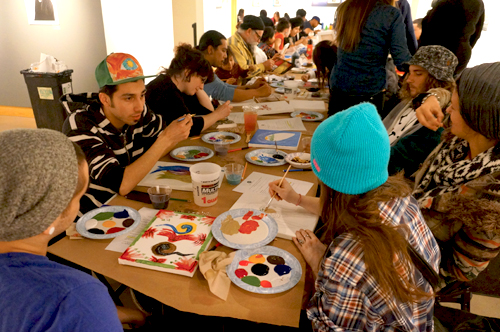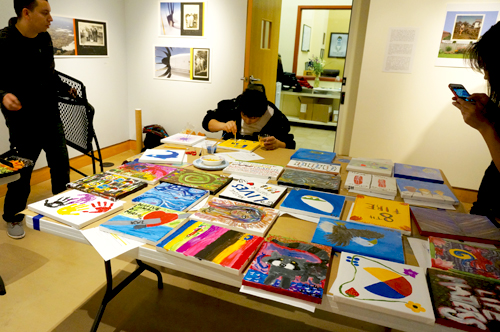 Art is powerful. For Indigenous
Art is powerful. For Indigenous
communities, art is medicine with incredible healing properties. It
is a way to create beauty in the messy process of decolonization. It
is also a means to educate, inspire and enliven Indigenous activist
movements.
Minneapolis is no stranger to
Indigenous activism, so the “Art of Resistance” exhibition
opening on the American Indian Cultural Corridor’s All My Relations
Gallery complemented the rich activist history in the Twin Cities.
The traveling exhibit reflect over 30 years of environmental justice
work of Honor the Earth, a national Native-led organization based in
White Earth, Minn. Featuring 20 Indigenous local and national
artists, the exhibit is only one aspect to a broader partnership and
collaborative effort to engage Native activists in the Twin Cities.
The Native American Community
Development Institute hosted a first of its kind “Community Art
Night” inspired by the “Art of Resistance” on Feb. 9. Graci
Horne, (Sisseton-Wahpeton Dakota) Associate Curator for All My
Relations Gallery, was inspired by similar events during her time as
a student at the Institute of American Indian Arts in Santa Fe, New
Mexico.
Over 50 community members came
together to share space, food and to create art together on small
canvases to express their own activist work. NACDI Community
Organizer Ashley Fairbanks (White Earth Ojibwe) shared insight about
the event, “It’s important for our community to see this gallery
as their space, as belonging to them.” Finished art pieces
completed by community members will be featured on the “Mni Art
Wall” appearing in Pow Wow Grounds Coffee Shop located next to the
gallery.
One of the mainstays of Indigenous
teachings is that at some point in Native lives, community members
have a chance to be leaders and bring forth their own gifts and
talents to benefit the community. Fairbanks believes the event is one
way to help bring out our people’s strengths, “This is an
opportunity for our community members who may not see themselves as
artists a chance to see themselves in that lens and to see their work
displayed.”
In the spirit of
activism, the exhibit’s youth work is designed to develop leadership
roles, using art to reconnect the Native community with the sacred
relationship to traditional tobacco. A partnership to that end is the
development of Native youth leadership project through the arts.
Lannesse Baker (Turtle Mountain Ojibwe), Native Youth Alliance of
Minnesota Executive Director, developed a partnership with Honor the
Earth Organizer and 2014 Bush Fellow Charlie Thayer (Lac Courte
Oreilles Ojibwe) and ClearWay Minnesota Senior Community Development
Manager CoCo Villaluz (Hidatsa) to co-facilitate a youth lead
initiative.
As 2012 Creative Community Leadership
Institute participants with Intermedia Arts in Minneapolis, Thayer
and Villaluz began discussing an arts project to share with the
American Indian community in the Twin Cities to promote well being.
The genesis of this project was born from their conversations. Thayer
understands the potential creativity has to make change in our
community, “There is power in activism through art. Visual art
plays an important role as it has the ability to stimulate and
encourage a unifying perspective. When channeled as a vehicle, it
carries issues of consciousness where it can be a catalyst for
meaningful change.”
Upcoming Mural Project
The Native Youth Alliance of Minnesota
was happy to host planning meetings that will ultimately lead to the
installations of three new mural projects in the East Phillips
community beginning in April 2015. Baker felt honored to be working
with youth and community on this project, “It’s a powerful
experience to work in partnership with youth and adults to co-create
and co-lead a creative process to use art to improve positive
presence in our community. We are hoping the community feels that
these pieces belong to them and inspire them toward their own
wellness.”
Native youth leaders participating in
the project have connected quite naturally with one another and to
the work itself. Sierra Villebrun (Bois Fort Ojibwe) is a junior at
All Nations South High School shared her perspective on decolonizing
through art, “The government keeps us secret because of everything
that has happened in this country. We’re here to tell the world
through our art that we’re still here and we’re here to tell the
truth in a beautiful way.” In this way, art proves to raise the
consciousness of Native culture.
Abel Martinez (Ho-Chunk) expressed his
ideas as well, “We have a chance to educate people [with the
murals] and have them learn things about our people they wouldn’t
regularly learn about.”
Of the three murals painted, one will
be on the First Nations Recovery Center, one on the Minneapolis
American Indian Center and the third at Little Earth of United
Tribes.
Gregg Deal (Pyramid Lake Paiute), a
contemporary Indigenous visual artist implementing the imagery of pop
culture to challenge stereotypes of Native people, accepted the
opportunity to lead the mural projects in the Twin Cities along with
visual artist Cheyenne Randall (Cheyenne River Sioux Tribe). He often
utilizes classic images by applying modern artistic layers, inviting
viewers into a new world one could only imagine.
Spending much time in Little Earth as
a child, Randall is self-taught and has been deeply influenced by his
late father, Robert Randall. He reflects upon his work, “There are
times when I complete a piece and take a step back and feel a
celestial collaboration with my father.” He feels he is continuing
in his legacy, “My father’s goal was to work with youth and
create murals one day.”
Deal and Randall will be working with
members of the Minneapolis American Indian community to hear what it
is they envision a healthy connection to tobacco and wellness and
implement these concepts that emerge from listening sessions into the
murals. In this way, these murals really do belong to the community.
Villaluz’s passion is to facilitate
tribal communities through a process of reclaiming sacred
relationship to tobacco. She believes strongly that through the arts,
this is a powerful way to return to traditional teachings. “We come
from a very unique place as Indigenous people and when we come
together, our Ancestors are there with us.”
Top photo: Twin Cities Native American community members come together to share
space and embrace creativity at the Community Art Night, inspired by
"The Art of Resistance" exhibit at All My Relations Gallery from Feb. 17
to May 9. (Photo by Deanna StandingCloud)
Bottom photo: Finished canvases from NACDI’s Art of Indigenous Resistance Community Art Night on Feb. 9. (Photo by Deanna StandingCloud)






